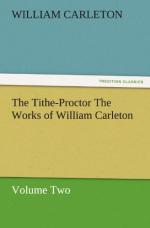Other scenes of violence and bloodshed there were, but none so frightful as the above. Most persons remember Rathcormac and Newtonbarry, but we do not imagine that a recapitulation of such atrocities can be at all agreeable to the generality of our readers, and for this reason we content ourselves with barely alluding to them, as a corroboration of the disorganized condition of society which then existed, and which we are now attempting to describe.
But perhaps nothing, after all, can test the inextinguishable hatred of tithes which prevailed at that period, more than the startling and almost incredible fact that the government, aided by as sound a lawyer, and as able an attorney-general as ever lived, and a powerful bar besides, were not able, during the following spring and summer assizes, to convict a single individual concerned in this massacre, which is now a portion of our country’s history, and still well remembered as that of Carrickshock, in the county of Kilkenny.
This double triumph of the people over the tithe and police, created a strong sensation throughout the kingdom, and even shook the two houses of parliament with dismay.
Indeed, there probably never existed in Ireland, any combination or confederacy of the people so bitter, or with such a deeply-rooted hold upon the popular mind as that against tithes, as it slumbered and revived from time to time. And what is rather singular, too, the frequent agitations arising from it, which in its periodical returns convulsed the country, were almost uniformly, or at least very frequently, productive of a collateral one against priests’ dues. Up until the year ’31, however, or ’32, the agitators against tithes were more for their reduction than their extinction. The reduction of tithes and priests’ dues went, as we have said, very frequently together, or rather the one generally produced the other. The Threshers, in their early existence, were as active in their attempts to diminish the income of the priests by intimidation, as they were that of the parson. Their plan was, with white shirts over their clothes, and white handkerchiefs round their hats so as to conceal the features, to pay a nightly visit to some quiet and timid man, whom they swore, on pain of death, to visit the neighboring chapel in order to inform the priest, in the face of his own congregation, that unless he reduced the fees for marriage to half-a-guinea, those of baptism to nineteen-pence half-penny, and celebrate Mass for thirteen pence, he might prepare his coffin. If he got hay and oats for his horse at a station, he was at liberty to take them, but if not, he was to depart quietly, on pain of smarting for it. The unfortunate individuals on whom they imposed this painful and dangerous duty, were much to be pitied whilst this confederacy lasted. To submit to an illegal oath, without reporting the matter to the next magistrate, was a capital felony, as it was voluntarily to execute




